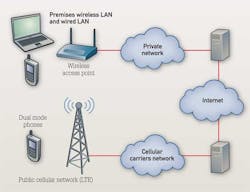The coexistence of wireless LANs and distributed antenna systems
Coordinated design efforts can result in appropriate overlay between the wireless communication types.
Scott Thompson, Oberon, Inc.
Information transportation system (ITS) professionals are being asked to provide more capabilities than ever before, on smaller budgets. Fortunately, Internet Protocol (IP) convergence has enabled voice, data, video, and security to be provided over a single network infrastructure. One form of communication generally not supported by the premises network is cellular mobile communications. With the proliferation of cellular telephones for critical business applications, and in particular dual mode smartphones, the ITS professional will next be asked to provide cellular services in the buildings which otherwise may not have particularly good coverage.
Cellular carriers have invested billions of dollars in spectrum purchases and infrastructure build-out to create the mobile network which was originally conceived to provide mobile communications outdoors. At one time, the cell phone was used “on the road,” and the desktop telephone was used in the office. Over time, users have become more dependent on cellular phones, no matter where they are. As many as 80% of cellular calls either originate or terminate within a building. Yet many buildings have poor cellular coverage within. Buildings create a significant impediment to propagation of the radio frequency (RF) waveform from the outdoor cellular base station on the tower to the handset within the building. Extending the reach of the cellular signal the last few hundred feet to every floor and room inside buildings has proven to be very challenging and expensive due to the high attenuation of building construction materials.
Enhancing the cellular coverage within the building is not only a matter of convenience for the building’s occupant or revenue for the cellular carrier. In some venues, such as on college campuses, there is a mandate to provide E 911 location enhanced emergency communications services with the cellular network. For this to be effective, building interiors must have adequate RF coverage.
A cellular DAS antenna and 6 MIMO wireless LAN antennas are colocated with DAS redistribution equipment and a wireless access point in this ceiling enclosure.
Waiting for the cellular carrier to enhance their networks to the degree that they will provide complete in-building coverage may not be a viable solution, as the carriers have many competing demands. Fortunately, there is a means to proactively provide in-building coverage called distributed antenna systems (DAS).
There are a number of different DAS alternatives which are suited to different applications, respectively. For college and business campuses, an outdoor DAS comprising micro-base stations is often used. The architecture is similar to the macro-cellular outdoor architecture carriers have deployed, however, rather than using large antennas on high towers, the micro-base station DAS uses small, inconspicuous base-stations and antennas distributed throughout the campuses (generally outdoors), which are able to provide coverage within the building.
A second architecture is called in-building DAS, which utilizes vendor equipment in the premises telecom room that is connected to redistribution equipment and antennas distributed throughout the facility. This approach may use copper twisted pair, fiber optics, or coaxial cabling for the distribution of the cellular call information throughout the building. This approach is often used in larger public venues and commercial buildings.
A third approach uses bidirectional amplifiers (BDAs). In this approach an outdoor antenna on the building rooftop accepts the cellular signal and the signal is amplified and distributed through the building with amplifiers, coaxial cable and service antennas. This approach is only appropriate for smaller buildings.
In any case, the DAS should be designed by a professional with experience in the field, and the design and installation must be coordinated with the carriers. The carrier has licensed the spectrum and has exclusive rights to it, and any amplification or redistribution must be approved by the carrier. Equipment vendors and third-party integrators can coordinate approval, and expedite the deployment of the DAS system for excellent in-building cellular coverage.
Increased in-building demand, higher bandwidth applications, and the growth in smartphones will severely tax the bandwidth capabilities of the cellular carriers. The cost of providing 3G and 4G services throughout all buildings, public and private, will be enormous. It has taken 30 years for the cellular carriers to achieve the cellular coverage currently available. Deployment of DAS systems will help to focus improved cellular coverage in places where it is most critically required, but will require the involvement of the cellular carriers, premises ITS managers, building owners, third-party integrators and equipment vendors.
The cellular network with DAS enhanced in-building coverage may provide effective coverage, but may chronically be challenged to provide adequate bandwidth for emerging mobile multimedia services, and will not provide the premises network connectivity desired. A private wireless LAN is still required to support the premises network mobile multimedia applications. To avoid confusion, this is a good point to provide a concise definition of the two services. The cellular network is the public mobile network provided by the carrier inside and outside of the premises. The wireless network, wireless LAN, or Wi-Fi network is the private wireless network within the premises
The DAS solutions are generally vendor specific, and transporting wireless LAN and DAS traffic over the same network may not be an ideal solution. DAS solutions concentrate some of the equipment in the telecom room, whereas, wireless LAN access points distributed throughout the building (rather than concentrated in the telecom room) is consistent with the 802.11 standard, and reduces telecom room crowding. Additionally, wireless LAN networks over DAS infrastructure may not be supported by the wireless LAN vendor. However, pathways, spaces, and facilities can be shared to reduce the cost of the independent wireless LAN with a DAS infrastructure. This DAS overlay on a wireless LAN is not only cost effective, but is technically feasible from a spectrum standpoint, as the cellular network and wireless LAN operate in different frequency bands, and therefore do not interfere with each other. (Cellular networks operate in bands from 700-2100 MHz; wireless LAN operates in 2400-5800MHz). The figure shows a single wideband DAS antenna and six MIMO wireless LAN antennas co-located in a single ceiling enclosure. The enclosure contains both the cellular DAS redistribution equipment or bidirectional amplifiers, and the wireless LAN access points. The antenna spacing is adequate to ensure enough isolation for proper operation of both the wireless LAN and cellular receivers.
The cellular network and the wireless LAN can coexist within the building, but will they have the ability to work together to improve overall capabilities? The answer is “yes” due to an emerging technology which will improve in-building mobile phone utility, reduce spectrum congestion on the cellular network, speed mobile deployments and reduce service costs. The emerging 4G network being deployed by the largest nationwide carriers (beginning later in 2010 and 2011) uses an LTE (Long Term Evolution) radio network. Within LTE is a protocol called IP Multimedia Services (IMS). IMS moves 4G cellular networks away from circuit-switched technology toward an all IP-based communication system. IMS is a higher layer protocol that permits QoS for multimedia and voice applications, and user authentication across both carrier and enterprise networks. Thus the opportunity exists to seamlessly integrate the private, premises IP network with the carriers IP mobile network.
Couple this with the fact that most smartphones are dual mode, meaning they contain both a cellular radio and a wireless LAN radio. With a dual mode smartphone on an IMS-enabled network, the opportunity exists to originate or terminate an in-building call on either the cellular network, or the premises wireless LAN network, and transport the call on the carrier’s cellular network. The other end of the call may, conversely, terminate or originate on either a premises wireless LAN or the cellular network.
The process of moving the call originating or terminating device off of the cellular network (and onto the premises wireless LAN) is called “offloading”. Historically, the carriers may not have wanted to lose these billable minutes. But with spectrum congestion and penetration issues, the carriers will probably be more amenable to offloading. Many times, the carriers do not bill for inbound (to the cell phone) calls so billable minutes are not lost anyway. Regardless of whether carriers permit offloading or not, the decision may not be in their hands. For example, Apple’s FaceTime feature allows Skype-like video calling iPhone 4 to iPhone 4 over the wireless LAN. The cellular network is not part of the video call (and cannot be, at this time).
With IMS moving the cellular network to an IP-based fixed architecture, then Fixed Mobile Convergence (FMC) is achievable, shown in the figure. FMC will enable every application to be accessed as easily on a cell phone as on a laptop on the wireless LAN or PC on the wired network. It also means that one telephone number and one unified messaging voice mailbox can be used on both mobile and fixed computing devices.
So what is the upshot for the ITS designer, installer, or manager? It appears that both the cellular network and the wireless LAN need to coexist and to provide complete building-wide coverage. The two networks may provide complementary services, and both must be designed to provide multimedia capabilities. Both the DAS for cellular coverage, and the wireless LAN, should be designed for robust RF coverage throughout the building. Coordination in design, installation and deployment can result in a cellular DAS overlay on wireless LAN with consequential reduction in deployment cost.
Scott Thompson is president of Oberon Inc. (www.oberonwireless.com)
Past CIM Articles


